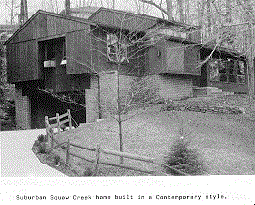Table of Contents
- Project Participants
- Introduction
- 1800 - 1836 Agricultural Settlement
- 1836 - 1860 Founding of the Town of Girard
- 1860 - 1890 Industrial Expansion
- 1890 to the Present
Project Participants
Book Authors
- Jane Harris
- James Dale
Contributors
- James Dale, Coordinator, American Studies, Youngstown State University.
- Elizabeth DeChant, Secretary, Girard Historical Society.
- Eugene Dukes, Director, Girard Free Library.
- Hugh Earnhart, Director, Oral History, Youngstown State University.
- Jane Harris, Columnist, Girard News
- Wendell Lauth, President, Girard Historical Society.
- Richard Ulrich, Architectural History, Youngstown State University.
- Carl Leet, Photography.
- Mary Ann Murray, Graphics.
Project date: 1984
Funding
Ohio Arts Council and the Ohio Humanities Council Joint Program in the Arts and Humanities
Girard Kiwanis
A Brief History of Girard: Its Architecture and Its People
Introduction
History can be told in many ways. This Girard history project tells the story of Girard through its architecture. This can make history more real by connecting it to the architectural structures we live among. The reason the town of Girard was founded 150 years ago was the dam on the Mahoning River that can still be seen from the viaduct. Since then, the architecture of Girard has deeply influenced how the people of Girard lived, how they worked, how they were educated, how they played, and how they thought about themselves and their world. This is the story told by the Girard History Project.
1800 - 1836 Agricultural Settlement
In 1798, the entire Connecticut Western Reserve was sold, for about fifty cents an acre, to a large group of land speculators who divided the land among themselves with a lottery. Liberty Township went to four men, none of whom lived in the area: Moses Cleaveland (who founded Cleveland), Daniel Lathrop, Christopher Liffinwell, and Sam Huntington Jr. (who became the third governor of Ohio). The township was surveyed into 25 Great Lots, each a mile square. The area that became Girard was located in Great Lot 10 on the southwest side of the township. This lot was particularly valuable because running through it were both the Mahoning River and the major State Road, (now Route 422) which became State Street in Girard.
The first settlers on Great Lot 10 were the family of Hieronimus Eckman, who bought the upper third of the lot sight-unseen in 1802, before coming west to clear it for a farm. They had nine children. Eckman was one of the first gunsmiths in the Mahoning Valley. In 1803, he petitioned to have a road built between Girard and Hubbard, now Route 304 (Churchill Road). The Eckmans came from Lancaster County in Eastern Pennsylvania. Although from Germany, settlers in this area of Pennsylvania became known as Pennsylvania Dutch. They were hardworking, thrifty farmers who were able to give their younger sons money to buy land in the "West." So many of these people settled in the Girard area that the area on the north side of Girard became known as Dutchtown.
The second settlers were the Francis Carltons. In 1801, they had settled in Warren on land north of the Kinsman Mansion, which is now Perkins Park, but they quickly sold this land and moved to the lower third of Great Lot 10. One of the first schools in the area was a log cabin on the Carlton land. Carlton was an Irishman from Western Pennsylvania, who had served in the Revolution, as had many of the men who settled in the West. He died in the great typhoid epidemic of 1813.The middle third of Great Lot 10 was bought by William Moore. He, too, died in the epidemic of 1813, and the property was sold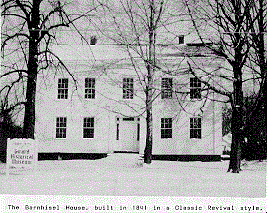 to Daniel Reeser, who in turn sold it to Solomon Kline, another German, for whom Kline Street was named. Some of the other early settlers were the Sam Everetts, the John Townsends, and the Henry Barnhisels. In 1813, the Barnhisels bought 318 acres of land just north of Great Lot 10. Over the years, this extended family accumulated more than 650 acres. They donated land for the first church in the area. The Union Church was built in Classic Revival style and served both the German Lutheran and German Reform congregations. In 1841, Henry Barnhisel Jr. built a mansion in Classic Revival style on his farm facing the State Road. This house is on the National Historical Register, and is located at 1011 North State Street. It is currently being restored by the Girard Historical Society with a $20,000 grant from the Department of the Interior.
to Daniel Reeser, who in turn sold it to Solomon Kline, another German, for whom Kline Street was named. Some of the other early settlers were the Sam Everetts, the John Townsends, and the Henry Barnhisels. In 1813, the Barnhisels bought 318 acres of land just north of Great Lot 10. Over the years, this extended family accumulated more than 650 acres. They donated land for the first church in the area. The Union Church was built in Classic Revival style and served both the German Lutheran and German Reform congregations. In 1841, Henry Barnhisel Jr. built a mansion in Classic Revival style on his farm facing the State Road. This house is on the National Historical Register, and is located at 1011 North State Street. It is currently being restored by the Girard Historical Society with a $20,000 grant from the Department of the Interior.
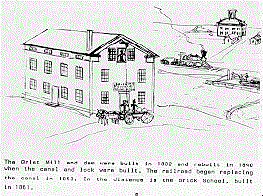 To serve the surrounding farms, a grist mill was built in 1832 by Henry Brunett, who sold it to Andrew McCartney. To provide water power, a dam was built across the river at the site of the present dam. The grist mill became the commercial center for what had now become a prosperous, growing agricultural area.
To serve the surrounding farms, a grist mill was built in 1832 by Henry Brunett, who sold it to Andrew McCartney. To provide water power, a dam was built across the river at the site of the present dam. The grist mill became the commercial center for what had now become a prosperous, growing agricultural area.
1836-1860 Founding of the Town of Girard
The founding of the town of Girard was the result of more land speculation and the planning of the Pennsylvania and the Ohio Canal. This canal was to run from the Ohio River, up the Beaver River and then up the Mahoning River and on to Akron, where it would connect with other parts of the Ohio canal system. It was obvious that the reservoir above the dam would be ideal for loading and unloading canal boats, which would expand the activity of this commercial center. A village that formed here would surely prosper, and as time went on, the land would become more and more valuable.
In 1836, four men bought the section of Solomon Kline's land between the river and the State Road to found the town of Girard. For this 42 acres, they paid $3,539, or $60 an acre. The county surveyor, Franklin E. Stow, spent one day on the survey. Apparently unaware of the name the four men had in mind, he called the town Mahoning. However, it has always been assumed that the town was named for Stephen Girard, the famous philanthropist of Philadelphia.
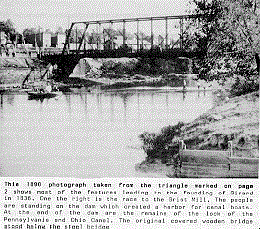
In contrast to the earlier land speculators who bought Liberty Township, all four of these men were prominent in the Mahoning Valley. John W. Seeley, 65, came from Pennsylvania and settled in Howland in 1801. He was one of the first doctors in Trumbull County. During the War of 1812, he recruited a company of militia and was elected its captain. He was a state senator from 1816 to 1817. He became an enthusiastic supporter of the canal company and one of its directors. On the inaugural boat trip from Girard to Akron in 1840 to celebrate completion of the canal, he became so excited that he became sick and died. John W. Collins came from Virginia. In 1835, he had bought the strip of land south of the tract the four bought together in 1836 and included this strip with the rest of the tract. He was a businessman and started a general store at Howland Corners.
Mathew Birchard, 32, was born in Massachusetts. He settled in Windham, studied law in Warren, and was admitted to the bar in 1827. He became a justice of the Ohio Supreme Court and later Chief Justice. David Tod, 31, was born in 1805 on his parents' farm in Brier Hill. He studied law in Warren, was admitted to the bar in 1827, and went into practice with Matthew Birchard in Warren. He was the first postmaster of Warren, was elected to the State Senate in 1840, ard appointed ambassador to Brazil in 1847. He returned to Warren, then to his family home in Brier Hill. In 1860, he was elected Governor of Ohio.
The Pennsylvania and Ohio Canal reached Girard in 1839. The dam was rebuilt into its present two-levee form and a granite lock serving the canal was built at the east end of the dam. Just below the dam, a covered wooden bridge was built across the river at the sight of the present viaduct. Andrew McCartney leased the mill to a partnership of Baldwin, Osborne, and Robbins, who rebuilt it into a two story structure in a Classic Revival style. It had a capacity of 70 barrels a day. Above the dam on the east side of the river, a basin was dug out for loading and unloading barges. The street running to the basin was named Basin Street, later changed to West Broadway. For the first time, heavy merchandise could be transported economically. The basin began to serve as an inland port exporting agricultural products produced in the area and importing manufactured goods from the outside world.
With the expectation and development of this commerce, the town of Girard began to develop. Fifteen blocks were initially surveyed and divided into lots. In 1837, four lots were sold. Henry Stull bought a lot at Kline and Water streets (near the basin) for $33. Elmedorus Crandon bought two lots at the main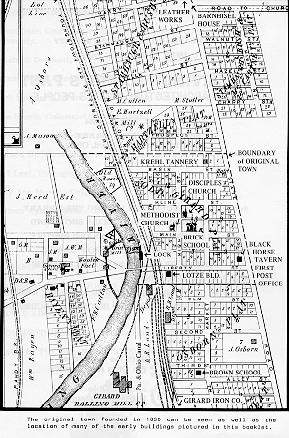 intersection of Liberty and State Streets for $60 and built the Black Horse Tavern, which became the first Post Office. In 1844, the first school was built on Liberty Street, but was later moved to the northwest corner of Abbey and South Market Streets, where it was called Brown School.
intersection of Liberty and State Streets for $60 and built the Black Horse Tavern, which became the first Post Office. In 1844, the first school was built on Liberty Street, but was later moved to the northwest corner of Abbey and South Market Streets, where it was called Brown School.
As the canal created wealth and reduced transportation costs, the people of Girard began to participate in the larger American culture. Heavy items such as china and church organs could now be afforded. New York clothing styles began to show up on Girard streets. In order to keep up with current national style the early citizens of Girard brought in classic revival architecture and incorporated it into the design of the first school, the Methodist Church, and the more expensive homes such as the Barnhisel House.
In 1835, the Cleveland and Mahoning Railroad reached Girard. It ran along the same path as the canal, which it rapidly replaced. The stockholders of the railroad were often the same people as the stockholders of the canal. David Tod became the President of the railroad in 1859.
In 1861, Girard's first brick building was constructed on Jefferson Square. It was a large elegant school in Italianate style. Although named Union School because it served the area surrounding Girard, it soon became known simply as the Brick School. It was a combination grade and high school, and also provided space for public entertainments and theatrical troupes. The first principal was Hugh Caldwell.
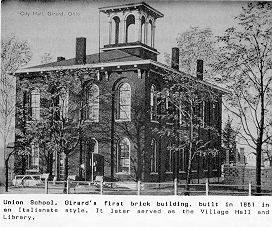
By 1860, the population of Girard was approaching 500 people.
1860-1890 Industrial Expansion
Beginning with the Civil War, Girard began to expand as it started to depend less on serving as a commercial center and began to develop its own industry. Utilizing hides produced by surrounding farms, a small tannery was established in 1860 by Fredrick Krehl, who had learned the trade in Canfield. His first building was located on the north side of Basin Street, now West Broadway. During the Civil War, business boomed from making leather for harnesses. In 1873, the Tannery expanded and eventually occupied most of the block north of Basin Street. It reached a capacity of 600 hides a week and employed more than 25 people, mostly Germans, who settled in the area just to the north of the Tannery which became known as Dutchtown. In 1904, most of the Tannery burned down, leaving only the building on West Broadway which now serves as the recycling center. Another industry which utilized raw materials produced by surrounding farms was the Woolen Factory, which was located near the Grist Mill.
But Girard's major industry rapidly became iron and steel. The area around Girard contained all the necessary raw materials, iron ore,coal, and limestone. Some of these materials were brought in by train from nearby locations such as Mineral Ridge. Others were mined right in the Girard area. Coal mines were dug in the hillside on the west side of the river valley. Welsh immigrants came to work these mines and settled in the area which became known as Welsh Hill.
In 1866, the Girard Iron Company was established on the south side along the river by David Tod, J(oseph) G. Butler, William Richards, and William Ward. It grew into a very large operation with a furnace 66 feet high which had a capacity of 20,000 tons a month. Its stock house was 60 feet wide and 200 feet long. In time this company became part of U. S. Steel.
In 1867, the Girard Stove Works was established on the west side of the river near the Grist Mill. It was built by Lambert Crawford and C. B. Vanbroclin, and after a series of ownership changes, ended up in the hands of a partnership of McCartney, Stambaugh, Walker, Kincaid, and Wilson. Expanding beyond stoves, it produced coal cars and castings as large as five tons, and employed over 25 workers. In time, it became part of Youngstown Foundry and Machine.
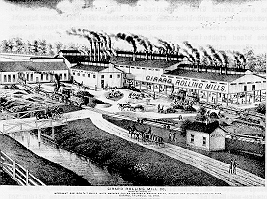 In 1872, a joint stock company established the Girard Rolling Mill on the south side along the river. The president was Henry Wick, the secretary-treasurer, Myron Wick, and the general manager, John Wick. Built in a functional Victorian industrial style, the mill grew to have fourteen puddling furnaces and a ten-inch rolling mill, and employed 153 workers. It specialized in steel for agricultural implements, chains,and nuts and bolts, and reached a capacity of 1,000 tons a month. he fire and smoke from the Rolling Mill and the Iron Company on the south side along the river was so reminiscent of Pittsburgh that this area became known as Allegeheny. The first workers in these mills were Welsh, followed by Italians in the 1880's. Often they were very young. During their breaks from puddling, they often heated their lunches on hot surfaces in the mill.
In 1872, a joint stock company established the Girard Rolling Mill on the south side along the river. The president was Henry Wick, the secretary-treasurer, Myron Wick, and the general manager, John Wick. Built in a functional Victorian industrial style, the mill grew to have fourteen puddling furnaces and a ten-inch rolling mill, and employed 153 workers. It specialized in steel for agricultural implements, chains,and nuts and bolts, and reached a capacity of 1,000 tons a month. he fire and smoke from the Rolling Mill and the Iron Company on the south side along the river was so reminiscent of Pittsburgh that this area became known as Allegeheny. The first workers in these mills were Welsh, followed by Italians in the 1880's. Often they were very young. During their breaks from puddling, they often heated their lunches on hot surfaces in the mill.
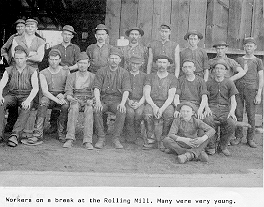 In response to the wealth this industry produced, the Girard Savings Bank was built in 1873 on the south side of Liberty Street in a Renaissance Revival Style. The first president was R. H. Walker and the initial capital was $50,000. Many new stores were built. On Liberty Street, a number of stores, along with the Opera House, were located in the Lotze Building, which was built in an elegant Renaissance Revival style. The Lotze Store had the first telephone in Girard.
In response to the wealth this industry produced, the Girard Savings Bank was built in 1873 on the south side of Liberty Street in a Renaissance Revival Style. The first president was R. H. Walker and the initial capital was $50,000. Many new stores were built. On Liberty Street, a number of stores, along with the Opera House, were located in the Lotze Building, which was built in an elegant Renaissance Revival style. The Lotze Store had the first telephone in Girard.
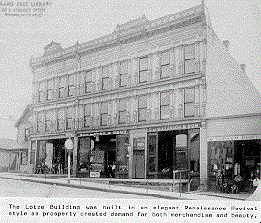
A volunteer fire department was organized around 1878, with a horse drawn engine. Its water supply came from a large cistern at the southwest corner of Liberty and Market Streets, where the town pump was located. This intersection was considered the center of town. The first newspaper, the Girard News, was established in 1882, but soon went out of business and there was no paper until the establishment in 1887 of the Girard Grit, a name reflecting the quality of the local air. The original wooden bridge was replaced with a cast iron bridge to handle the increasingly heavy traffic crossing the river
A wealthy business class began to emerge, which sought to demonstrate its success by building mansions. Zenas Kline, who made his money in cattle and coal, built an Italianate mansion on his estate on Churchill Road. The Richards-Morris house (both men made their money in coal and iron) was built in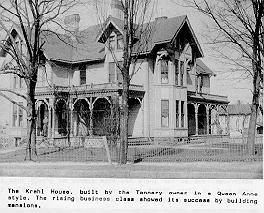 an Italianate style on the hill east of State Street where the bowling alley now stands. Frederick Krehl built a large Victorian mansion at the corner of State and West Broadway on the site of his tannery (as was often the custom) so that he could overlook his domain. His son, J. C. Krehl, built a similar mansion on the opposite side of State Street.
an Italianate style on the hill east of State Street where the bowling alley now stands. Frederick Krehl built a large Victorian mansion at the corner of State and West Broadway on the site of his tannery (as was often the custom) so that he could overlook his domain. His son, J. C. Krehl, built a similar mansion on the opposite side of State Street.
The workers also tended to settle within easy walking distance of their work. At first they lived in small row houses, which they rented from speculator-contractors. As they made more money, they often bought these houses. Those who made even more money 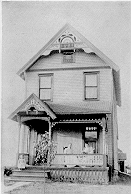 often sought, like the rich, to add style to their homes by embellishing them with decorative touches.
often sought, like the rich, to add style to their homes by embellishing them with decorative touches.
Shiloh Lodge of Ohio, No. 16, of the Amalgamated Association of Iron and Steel Workers was organized in 1876. The first president was Thomas S. Evans. It held meetings in the Odd Fellows Hall. Girard Lodge, No. 432, of the Independent Order of Odd Fellows had been organized in 1869, and had acquired its own lodge rooms on Liberty Street. Friendship Lodge, No. 65, of the Knights of Pythias was organized in 1874. It had the first band in Girard. Court Lilly, No. 6625, of the Ancient Order of Foresters was organized in 1880.
The Methodist Episcopal Church was organized by Rev. Dillon Prosser in 1843. It met in the log school house on the Carlton property, the site later occupied by the home of Obadiah Sheadle. In 1852, a small chapel was built, and in 1880, a large Gothic Revival church was built at the corners of Main and Market Streets. The Disciples Church was organized in 1876 and met in the brick school until in 1871 when it was able to build a church at the northwest corner of Jefferson Square in a delicate Gothic Revival style.
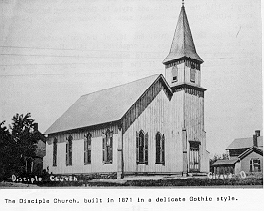
In the summers, there were boat races on the reservoir above the dam and the canoe club paddled up and down the river. When the river froze over in the winter, there were sleigh races and young people skated as far north as Warren. There were stops along the river for hot chocolate and warm fires burned along the way. The Lotze family owned a fleet of rowboats on the river and a picnic grounds on the west side of the river. Parties came by train and horse and buggy from surrounding communities and took boats up the river to the picnic grounds. The Methodist Church also had picnic grounds across the river. The first roller skating rink was built on West Wilson Avenue. The north side of Cherry street was known as the "commons", the first circus grounds.
By 1890, Girard had expanded north to the cemetery and south to the county line. The area directly south of the original town became known as Shooktown, the area south of that became known as Mosier, and the area further south to the county line was called Gandertown. But so far there had been almost no growth into the area east of State Street which still had farms.
By 1890, the population of Girard had surpassed 1,000 people.
1890 to the Present
Due to the growing need for government services (which had always been provided by Liberty Township), in 1893 Girard was incorporated into a village with its own mayor and council. Ambrose Eckman was elected the first mayor. He ran on a citizen's ticket composed of both Republicans and Democrats, and defeated the Republican candidate. The old Brick School, which had its student load reduced when the Wilson Avenue School was built in 1887, now did double service as the first Village Hall. It became the Village Hall alone in 1905 when the North Avenue School was built. As the village hall, it also served a variety of other community needs, such as a place for rolling bandages during the First World War.
In 1896, the trolley came to Girard. It ran along State Street and tied into the trolley systems of Youngstown, Niles, Warren, and beyond. For the first time, people in Girard had easy access to the larger communities around Girard. In the same year, Girard developed another means for improved  communication by establishing the first telephone exchange, which was located over Knapp's Store. There were 29 initial subscribers and two operators, one of whom was Miss Emma Reapsummer. Around this time, the cast iron bridge over the river was replaced with a stronger and wider steel bridge.
communication by establishing the first telephone exchange, which was located over Knapp's Store. There were 29 initial subscribers and two operators, one of whom was Miss Emma Reapsummer. Around this time, the cast iron bridge over the river was replaced with a stronger and wider steel bridge.
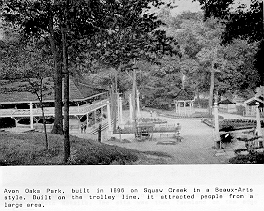 Also in 1896, an amusement park was established close to the intersection of North State Street with Squaw Creek. Originally called Squaw Creek Park, the name was later changed to a more elegant Avon Oaks. It was built in a Beaux-Arts style. Accessible to people from a large area via the new trolley, it was what was commonly called a trolley park. Dances were held in the great ballroom, sometimes with name bands. Circled in front were concessionaires and rides, and on the lower level there was a zoo. One of the most successful concessions was "Jake" Mock. The great ballroom has now become Avon Oaks Ballroom.
Also in 1896, an amusement park was established close to the intersection of North State Street with Squaw Creek. Originally called Squaw Creek Park, the name was later changed to a more elegant Avon Oaks. It was built in a Beaux-Arts style. Accessible to people from a large area via the new trolley, it was what was commonly called a trolley park. Dances were held in the great ballroom, sometimes with name bands. Circled in front were concessionaires and rides, and on the lower level there was a zoo. One of the most successful concessions was "Jake" Mock. The great ballroom has now become Avon Oaks Ballroom.
In 1899, the Ohio Leather Works was established on North State Street where the Barnhisels originally had had their maple sugar grove. The first owner was Joseph Smith, who lived in the Barnhisel House. Built in a functional industrial style, it specialized in fine leathers for products such as gloves, which were shipped all over the world. It became the largest processor of calf leather in the United States and employed over 500 people.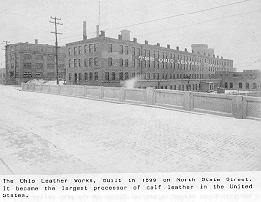
In 1905, the North Avenue School was built on what was then the edge of town. Designed by the well-known Youngstown architect, Charles H. Owsley, it was built in a Beaux-Arts style with Classic details. It served as the grade school, while the Wilson Avenue School served as the high school.
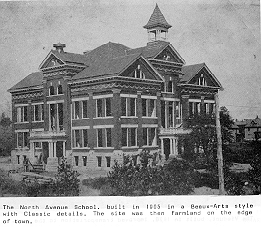
One of the first theaters was the Luna Theater located on State Street. It ran silent movies, which were accompanied by piano mood music played by the owner's wife. Later, the Mock Theater--which became the Wellman Theater--served Girard's needs until the coming of TV when family movies faded from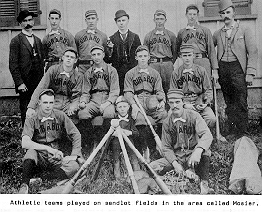 the scene. Football teams met on a field near Mosier, where young men played each other and the young ladies watched from benches placed around the field. Girard had baseball greats in its time who had played on the same sand lot fields at the south of town.
the scene. Football teams met on a field near Mosier, where young men played each other and the young ladies watched from benches placed around the field. Girard had baseball greats in its time who had played on the same sand lot fields at the south of town.
As Girard continued to grow, the land along the river became filled up, and the town began to expand up the side of the river valley east of State Street. By 1910, the population had reached 3,736 and by 1920, this number nearly doubled to 6,556. This gave Girard the size required by Ohio law to become a city in 1921. The Village Hall now became the City Building. Also in 1921, the Girard Free Library was established. It was housed in the City Building until 1973 when its present building was constructed in a contemporary style on East Prospect Street. Liberty Park was built in an Art Deco style on Little Squaw Creek as a memorial to the men who served in World War I. It was paid for with unused money raised for the war by veterans' organizations and the Kiwanis.
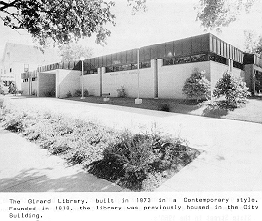
In 1928, after years of promotion by organizations such as the Kiwanis, the Viaduct was built at a cost of more than a million dollars. This multi-arched, reinforced concrete structure spanned the entire valley, bridging not only the river, but also the railroads on both sides of the flood plain. This provided a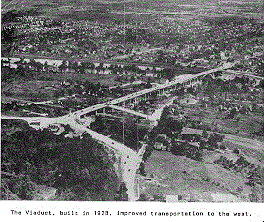 direct route to the steel area of McDonald across the river and prevented railroad crossing accidents, which had become common. Unfortunately, it also isolated beneath the Viaduct the oldest parts of the town along both sides of the river. In 1937, the present Post Office Building was built. The Post Office had always been housed in rented space such in the Black Horse Tavern. In 1938, the old Brick School-City Building was torn down and replaced by the present City Building. In 1935, the Syro Steel Company was started in a garage by Charles Syak and his family. The present plant was built on North State Street, north of Squaw Creek. Specializing in steel guard rails for highways, Syro Steel has grown into an international giant which has become the major employer in Girard. The Benada Aluminum Company was formed on South State Street in the 1960's.
direct route to the steel area of McDonald across the river and prevented railroad crossing accidents, which had become common. Unfortunately, it also isolated beneath the Viaduct the oldest parts of the town along both sides of the river. In 1937, the present Post Office Building was built. The Post Office had always been housed in rented space such in the Black Horse Tavern. In 1938, the old Brick School-City Building was torn down and replaced by the present City Building. In 1935, the Syro Steel Company was started in a garage by Charles Syak and his family. The present plant was built on North State Street, north of Squaw Creek. Specializing in steel guard rails for highways, Syro Steel has grown into an international giant which has become the major employer in Girard. The Benada Aluminum Company was formed on South State Street in the 1960's.
As automobiles first became available in the 1920's and 1930's, Girard became a "bedroom community" serving the larger cities around it. Large subdivisions of Beaux-Arts working class homes were built on the east side. After World War II, this suburbanization continued on the side of the valley almost to Route 193. Ethnic isolation surrendered to the melting pot as the children of immigrants moved out of their ethnic neighborhoods and into common suburbs. On the east side of Squaw Creek development has been built in a contemporary style. On the west side stand the functional industrial structures of Syro Steel.
Since the log cabins of the first settlers, the architecture of Girard has had a major effect on the people of Girard. It determined where the village was founded, who came to Girard, in what part of town they settled, and how ethnic groups would be segregated. It determined what kind of work people did and where they worked. It created environments for education, public service, worship, and play. Its style followed the national trends through which people sought to express social status and the level of their culture. Through its beauty, the architecture helped to raise the aesthetic life of Girard above the mere level of survival.
